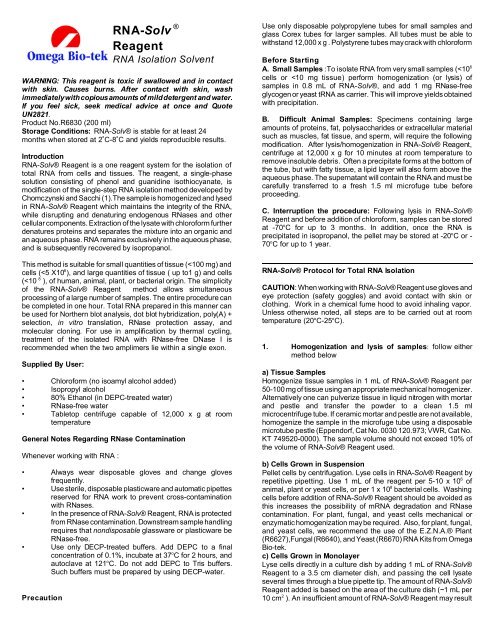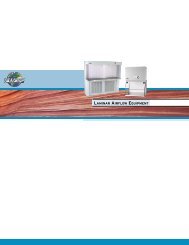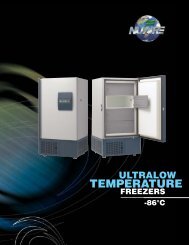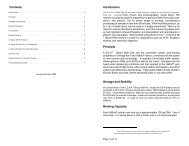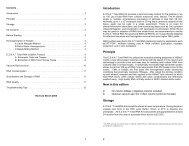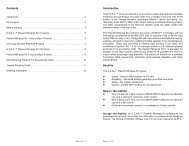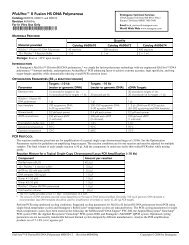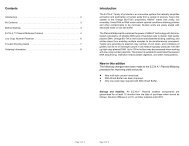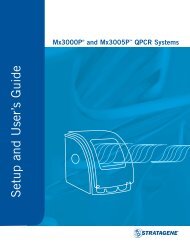RNA-Solv ® Reagent
RNA-Solv ® Reagent
RNA-Solv ® Reagent
Create successful ePaper yourself
Turn your PDF publications into a flip-book with our unique Google optimized e-Paper software.
<strong>RNA</strong>-<strong>Solv</strong> ®<strong>Reagent</strong><strong>RNA</strong> Isolation <strong>Solv</strong>entWARNING: This reagent is toxic if swallowed and in contactwith skin. Causes burns. After contact with skin, washimmediately with copious amounts of mild detergent and water.If you feel sick, seek medical advice at once and QuoteUN2821.Product No.R6830 (200 ml)Storage Conditions: <strong>RNA</strong>-<strong>Solv</strong>® is stable for at least 24months when stored at 2C-8C and yields reproducible results.Introduction<strong>RNA</strong>-<strong>Solv</strong>® <strong>Reagent</strong> is a one reagent system for the isolation oftotal <strong>RNA</strong> from cells and tissues. The reagent, a single-phasesolution consisting of phenol and guanidine isothiocyanate, ismodification of the single-step <strong>RNA</strong> isolation method developed byChomczynski and Sacchi (1).The sample is homogenized and lysedin <strong>RNA</strong>-<strong>Solv</strong>® <strong>Reagent</strong> which maintains the integrity of the <strong>RNA</strong>,while disrupting and denaturing endogenous RNases and othercellular components. Extraction of the lysate with chloroform furtherdenatures proteins and separates the mixture into an organic andan aqueous phase. <strong>RNA</strong> remains exclusively in the aqueous phase,and is subsequently recovered by isopropanol.This method is suitable for small quantities of tissue (
in contamination of the isolated <strong>RNA</strong> with DNA. Always use more<strong>RNA</strong>-<strong>Solv</strong>® <strong>Reagent</strong> if in the lysate is too viscous to aspirate witha pipette.2. Add 0.2 mL of chloroform per 1 mL of <strong>RNA</strong>-<strong>Solv</strong>®<strong>Reagent</strong>. Cap sample tubes securely and vortexvigorously for 15 seconds. Incubate on ice for 10 minutes.This step is critical - do not change it.3. Centrifuge the samples at no more than 12,000 x g for 15minutes at room temperature. The mixture separates intoa lower phenol-chloroform phase, an interphase, and anupper aqueous phase. <strong>RNA</strong> remains entirely in theaqueous phase.4. Precipitation of <strong>RNA</strong>. Transfer no more than 80% of theaqueous phase to a fresh tube, and discard the lowerorganic phase. Precipitate the <strong>RNA</strong> from the aqueousphase by adding 500 l of isopropyl alcohol per 1 mL of<strong>RNA</strong>-<strong>Solv</strong>® <strong>Reagent</strong> used for the initial homogenization.Incubate samples at room temperature 10 minutes andcentrifuge at no more than 12,000 x g for 10 minutes alsoat room temperature.Carbohydrate-rich samples: Plant samples of high polysaccharidecontent or animal tissues rich in glycosaminoglycans(proteoglycans) require the following modified precipitation methodfor obtaining pure <strong>RNA</strong>. Prepare Buffer A ( 1.2 M sodium chloride,800 mM sodium citrate). Following step 3, add to the aqueousphase 0.3 ml isopropanol followed by 0.3 ml Buffer A per 1 ml<strong>RNA</strong><strong>Solv</strong> ® <strong>Reagent</strong> used in step 1. Vortex to mix and centrifugeat no more than 12,000 x g for 10 minutes at room temperature.This high salt precipitation will reduce co-purification of complexcarbohydrates.5. Wash <strong>RNA</strong> pellet. Discard the supernatant and wash the<strong>RNA</strong> pellet once with 1 ml 80% ethanol. Mix the sample byvortexing and centrifuge at no more than 7,500 x g for 5minutes at room temperature.4. Reconstitute <strong>RNA</strong>. Carefully aspirate and discard theethanol and briefly AIR DRY the <strong>RNA</strong> pellet for 2-5minutes at room temperature.10 minutes). Do not usecentrifugal devices equipped with a vacuum source asover-drying will lead to difficulty in re-dissolving <strong>RNA</strong> inwater. Dissolve <strong>RNA</strong> in RNase-free water - a 5 minuteincubation at 60oC may be required. <strong>RNA</strong> can also bereconstituted in 100% formamide (deionized) and storedat -70C.<strong>RNA</strong> is now suitable for RNase protection, northern analysis andreverse transcriptase reactions. For isolation of poly(A)+ <strong>RNA</strong> anadditional ethanol precipitation is required. Add 1/8 X volume ofRNase-free 3M NaOAc, pH 6.0 followed by 2.5 X volume absoluteethanol. Vortex to mix and incubate at room temperature for 5minutes. Centrifuge at 12,000 x g for 10 min at room temperatureand discard the supernatant. Wash the pellet as before andreconstitute in DECP-treated water.Determination of Yield and Qualitymaterial, and on condition of storage prior to processing. Forassessing the quality of <strong>RNA</strong>, we recommend you performdenaturing agarose gel electrophoresis to confirm the integrity ofpurified material. Invariably, the full spectrum of <strong>RNA</strong>s, including4S and 5S species are purified with <strong>RNA</strong>-<strong>Solv</strong>® <strong>Reagent</strong>.Expected Yields per 1 mg tissue or 10 6 cells:Liver and spleen, 5-10 gKidney, 2-5 gBrain, 1-2 gEndothelial cells, 7-12 gFibroblasts, 6-8 gTroubleshooting• Low <strong>RNA</strong> Yields: Incomplete lysis of samples in <strong>RNA</strong><strong>Solv</strong><strong>Reagent</strong>. <strong>RNA</strong> pellet not completelt dissolved in DEPCwater.pH of diluent used for spectrophotometric analysisis too low.• Degraded <strong>RNA</strong>: Tissues were not immediately processedor frozen. Inadequate storage of starting material prio toisolation. Inadequate storage of <strong>RNA</strong> (-5 to -20C, insteadof -60 to -70C) Trypsin/EDTA was used in dislodgingmonolayer cells. Buffers or plasticwasre were not RNasefree.Formaldehyde used for denaturing agarose-gelelectrophoresis had a pH below 3.0.• Low Abs260/Abs280 ratios: Sample was diluted in waterrather than TE. Acidic pH lowers absorbance ratios. UseTE buffer as diluent for readings. Insufficient <strong>RNA</strong><strong>Solv</strong><strong>Reagent</strong> was used for lysis of sample. Ice incubation instep 2 was not performed. The aqueous phase wascontaminated with the phenolic phase.• DNA contamination of <strong>RNA</strong>: Too little <strong>RNA</strong><strong>Solv</strong> <strong>Reagent</strong>used for sample processing causing inadequateseparation of DNA/nucleoprotein complexes from aqueous<strong>RNA</strong>. The aqueous phase was contaminated with thephenol phase.Technical Support:Omega Bio-tek, USA - call toll-free : 1 888 832 8896References:1. Chomczynski, P., and Sacchi, N. Anal. Biochem. 162, 156(1987).2. Chomczynski, P. Biotechniques 15, 532 (1993).For laboratory research use only.CAUTION: Not for diagnostic use. The safety and efficacy ofthis product indiagnostic or other clinical uses has not been established.May,1999 (C). All rights reserved by Om ega Bio-tek, Inc.<strong>RNA</strong>-<strong>Solv</strong> is a registered mark of Omega Bio-tek, Inc.UV spectrophotometric analysis of the purified <strong>RNA</strong> is required forobtaining yield. To do so, dilute the <strong>RNA</strong> in an appropriate volumeof TE buffer, pH 8.0 (not water; <strong>RNA</strong> yields low Abs ratio values ifdissolved in acidic buffers) and measure absorbance at 260 nmand at 280 nm.<strong>RNA</strong> Conc = 40 g/ml X Dilution factor X Abs 260 nmTypical Abs 260 nm/ 280 nm ratios of 1.7-1.9 are obtained with theprotocol. Yields vary depending of type and amount of starting


